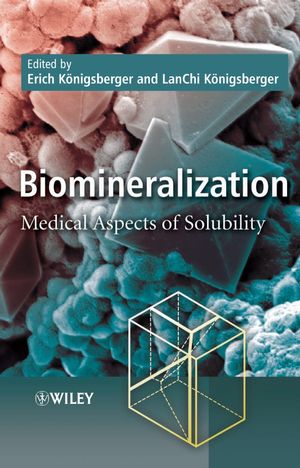Biomineralization: Medical Aspects of SolubilityISBN: 978-0-470-09209-5
Hardcover
302 pages
August 2006
 |
||||||
Foreword.
Preface.
Acknowledgements.
1 Solubility Phenomena Related to Normal and Pathological Biomineralization Processes (Erich Königsberger and LanChi Königsberger).
1.1 Introduction.
1.2 Experimental Methods.
1.2.1 Solubility Measurements.
1.2.2 Solution Calorimetry.
1.2.3 Kinetic Measurements.
1.3 Thermodynamic Modeling of Biological Systems.
1.3.1 Introduction.
1.3.2 Chemical Speciation, Blood Plasma Models and Chelation Therapy.
1.3.3 Metal Solubility and Toxicity.
1.3.4 Urine Models.
1.3.5 Modeling Pancreatic and Biliary Stone Formation.
1.4 New Insights in Solubility Phenomena Relevant to Biomineralization.
1.4.1 Solubility of Nanomaterials and Biological Demineralization.
1.4.2 New Mechanisms of Biomineralization.
References.
2 Mechanisms of Renal and Salivary Calculi Formation and Development (Félix Grases and Antonia Costa-Bauzá).
2.1 Introduction.
2.1.1 Renal Lithiasis.
2.1.2 Sialolithiasis.
2.2 Classification of Renal Calculi and Formation Mechanisms.
2.2.1 Calcium Oxalate Renal Calculi.
2.2.2 Phosphate Renal Calculi.
2.2.3 Calcium Oxalate Dihydrate/Hydroxyapatite Mixed Calculi.
2.2.4 Uric Acid Renal Calculi.
2.2.5 Cystine Renal Calculi.
2.2.6 Infrequent Renal Calculi.
2.2.7 General Considerations About Renal Calculi.
2.3 Mechanisms of Formation of Sialoliths.
References.
3 Calcium and Magnesium Phosphates: Normal and Pathological Mineralization (M. Clara F. Magalhães, Paula A. A. P. Marques and Rui N. Correia).
3.1 Introduction.
3.2 Stability of Magnesium and Calcium Phosphates.
3.2.1 Magnesium Phosphates.
3.2.2 Whitlockite (TCMP).
3.2.3 Calcium Phosphates.
3.3 Calcium Diphosphate Dihydrate.
3.4 Biological and in Vitro Occurrences of Calcium and Magnesium Phosphates.
3.4.1 Normal Calcifications – Bones and Teeth.
3.4.2 Pathological Calcifications.
3.4.3 Calcium Phosphate Biomaterials.
Acknowledgements.
References.
4 Relevance of a Polymer-Induced Liquid-Precursor (PILP) Mineralization Process to Normal and Pathological Biomineralization (Fairland F. Amos, Matthew J. Olszta, Saeed R. Khan and Laurie B. Gower).
4.1 Introduction.
4.1.1 Crystallization Mechanisms.
4.1.2 In Vitro Models of Biomineralization.
4.1.3 Influence of Additives on Crystal Nucleation.
4.1.4 Influence of Additives on Crystal Growth.
4.2 Bone.
4.2.1 The Structure of Bone.
4.2.2 The Properties of Bone.
4.2.3 The Organic Matrix of Bone.
4.2.4 The Mineral Phase of Bone.
4.2.5 Formation of Bone.
4.2.6 Biomimetic Methods for Mineralizing Collagen.
4.2.7 Mineral Precursor Phases.
4.2.8 Concluding Remarks on Bone Formation.
4.3 Kidney Stones.
4.3.1 Free vs Fixed Particle Mechanisms.
4.3.2 The Complex Urinary Environment.
4.3.3 Mixed Composite Stones with CaP Core.
4.3.4 Morphological Clues of Crystallization Mechanism.
4.3.5 Concluding Remarks on Stone Formation.
References.
5 Pathological Biomineralization of Iron (Wanida Chua-anusorn and Timothy G. St Pierre).
5.1 Introduction.
5.1.1 Biogenic Iron Oxides.
5.1.2 Iron Metabolism.
5.1.3 Iron Overload.
5.1.4 Iron Oxide Deposits in Tissues.
5.1.5 Disease Specific Chemical Speciation of Hemosiderin Iron.
5.1.6 Transformation of Ferrihydrite to Goethite.
5.2 Reactivity of Pathological Iron Oxide Deposits.
5.2.1 Iron Oxide Isolation and Characterization.
5.2.2 Materials.
5.2.3 Isolation of the Iron Storage Components from Tissues.
5.2.4 Methods.
5.2.5 Results.
5.2.6 Discussion.
5.3 Accessibility of Hemosiderin Iron to an Iron Chelator.
5.3.1 Materials and Methods.
5.3.2 Results.
5.3.3 Discussion.
5.4 Concluding Remarks.
References.
Index.



